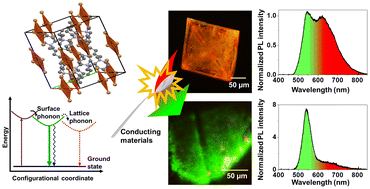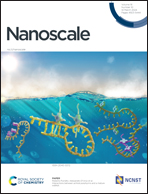Dual-color photoluminescence modulation of zero-dimensional hybrid copper halide microcrystals†
Abstract
Zero-dimensional hybrid copper(I) halides (HCHs) are attractive due to their interesting photoluminescence (PL) properties and the high abundance and low toxicity of copper. In this study, we report green–red dual emission from rhombic 1-butyl-1-methyl piperidinium copper bromide [(Bmpip)2Cu2Br4] microcrystals (MCs) prepared on borosilicate glass. The structure and elemental composition of the MCs are characterized by single crystal X-ray diffraction analysis, scanning electron microscopy, and energy-dispersive X-ray spectroscopy. Interestingly, MCs prepared on an ITO-coated glass plate show an intense green emission compared to the dual emission on a bare glass or plastic substrate. Furthermore, the intensity of the green emission from the MC is enormously increased by powdering using a conductive material, suggesting the deactivation of the red-emitting state by a charge transfer interaction with the conductor. These findings open a new strategy to suppress the self-trapping of excitons by longitudinal optical phonons and control the dual emitting states in HCHs.

- This article is part of the themed collection: Nanoscale 2024 Emerging Investigators


 Please wait while we load your content...
Please wait while we load your content...